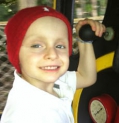Neural Crest Gene Regulatory Networks Underlying Normal Meningeal Development and Onset of Meningioma

Project Goal:
Project Update 2024:
Meningiomas are typically benign tumors that arise from the meninges of the central nervous system because of mutations in the gene NF2 or as a result of cranial radiotherapy treatments in pediatric cancer patients. To treat meningiomas effectively, it is critical to understand the cell type of origin for the tumors. I used the animal model zebrafish to study meninges development and meningeal tumor formation. I have established cell-type specific zebrafish transgenic lines expressing fluorescent proteins in meningeal progenitor cells derived from the neural crest and mesoderm origin stem cells. These lines will aid in visualizing meningeal progenitor cells and help us track them across development. Additionally, I have generated a zebrafish tumor model that develops meningioma using conditional gene editing techniques. I can pinpoint the cell type of origin for meningeal tumors by combining cell visualization via transgenic line, gene editing to generate tumors, and state of-the-art imaging and sequencing technologies.
Final Project Update 2025:
I have created transgenic lines that label the meningeal progenitors and have characterised their development and transcriptional signatures. Furthermore, I have produced a zebrafish tumor model that induces meningioma by applying conditional gene editing techniques. These hyperproliferating meningeal fibroblasts demonstrate transcriptional signatures reminiscent of muscle cells indicating cell type transformation. Additionally, I have established that NF2 along with other pediatric meningioma associated genes regulate cellular proliferation and spatial distribution in a combinatorial fashion. In conclusion, by integrating cell visualization using transgenic lines, tumor generation through gene editing, and advanced imaging and sequencing technologies, I can accurately identify the cell type from which meningeal tumors originate.

